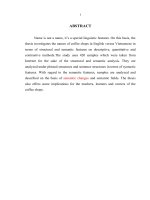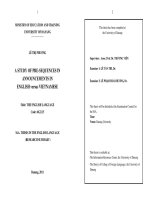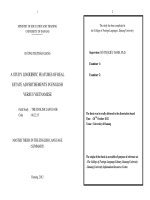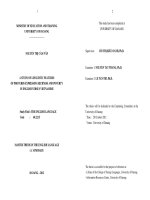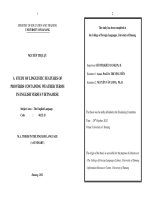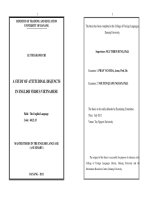A study of rhetorical devices in titles of online tourism newspapers in english versus vietnamese
Bạn đang xem bản rút gọn của tài liệu. Xem và tải ngay bản đầy đủ của tài liệu tại đây (2.76 MB, 121 trang )
F
THE UNIVERSITY OF DANANG
UNIVERSITY OF FOREIGN LANGUAGE STUDIES
PHẠM THỊ PHƯƠNG ANH
A STUDY OF RHETORICAL DEVICES
IN TITLES OF ONLINE TOURISM NEWSPAPERS
IN ENGLISH VERSUS VIETNAMESE
MASTER THESIS IN
LINGUISTICS AND CULTURAL STUDIES OF
FOREIGN COUNTRIES
Da Nang, 2020
THE UNIVERSITY OF DANANG
UNIVERSITY OF FOREIGN LANGUAGE STUDIES
PHẠM THỊ PHƯƠNG ANH
A STUDY OF RHETORICAL DEVICES
IN TITLES OF ONLINE TOURISM NEWSPAPERS
IN ENGLISH VERSUS VIETNAMESE
Major: ENGLISH LINGUISTICS
Code: 822.02.01
MASTER THESIS IN
LINGUISTICS AND CULTURAL STUDIES OF
FOREIGN COUNTRIES
Supervisor: Assoc. Prof. Dr. Nguyễn Thị Quỳnh Hoa
Da Nang, 2020
ii
ABSTRACT
This thesis studied rhetorical devices in titles of online tourism
newspapers in English and Vietnamese. An analysis was made to find out
the commonly used rhetorical devices and point out the similarities and
differences between them in English and Vietnamese titles of online tourism
newspapers. The data of this study were collected from two online
newspapers in English and Vietnamese namely Travel Daily News and
Du Lich.
stylistic
The
data
were
descbribed
and
contrastively
analyzed
on
aspects under qualitative and quantitative approaches. On the basis of
a contrastive analysis, the thesis tried to find out commonly used rhetorical
devices in English and Vietnamese titles of online tourism newspapers, namely
metaphor, metonymy, simile, personification, rhetorical questions, stylistic
inversion, enumeration, alliteration, and rhyme. The analysis was based on 400
samples (200 in English and 200 in Vietnamese), which were collected from
popular and prestigiuos online toursim newspapers in English and Vietnamese.
On the basis of the findings, this thesis set out some implications and
suggestions for teaching and learning both languages. The research result could
be useful for teachers, copywriters, freelancers and learners of English, as
well as those who are interested in tourism, linguistics and language in use.
iii
TABLE OF CONTENTS
STATEMENT OF AUTHORSHIP ......................................................................... i
ABSTRACT .............................................................................................................. ii
TABLE OF CONTENTS........................................................................................ iii
LIST OF ABBREVIATIONS ................................................................................ vi
LIST OF TABLES ................................................................................................. vii
LIST OF FIGURES ............................................................................................... vii
Chapter One. INTRODUCTION ............................................................................1
1.1. RATIONALE .......................................................................................................1
1.2. AIMS AND OBJECTIVES OF THE STUDY ....................................................2
1.2.1. Aims of the study ........................................................................................2
1.2.2. Objectives of the study ...............................................................................2
1.3. RESEARCH QUESTIONS..................................................................................2
1.4. SCOPE OF THE STUDY ....................................................................................3
1.5. SIGNIFICANCE OF THE STUDY .....................................................................3
1.6. ORGANIZATION OF THE STUDY ..................................................................3
Chapter
Two.
LITERATURE
REVIEW
AND
THEORETICAL
BACKGROUND .......................................................................................................5
2.1. LITERATURE REVIEW.....................................................................................5
2.2. THEORETICAL BACKGROUND .....................................................................7
2.2.1. Definition of Online Tourism Newspaper ..................................................7
2.2.2. Definition and features of titles of online tourism newspapers ..................9
2.2.3. Definition of Rhetorical Devices ..............................................................11
2.2.4. Functions of Rhetorical Devices ..............................................................12
2.2.5. Classification of Rhetorical Devices ........................................................13
2.3. SUMMARY .......................................................................................................23
Chapter Three. RESEARCH METHODS............................................................24
3.1. RESEARCH DESIGN .......................................................................................24
iv
3.2. RESEARCH METHODS...................................................................................24
3.3. DATA COLLECTION.......................................................................................24
3.4. DATA ANALYSIS ............................................................................................26
3.5. RESEARCH PROCEDURE ..............................................................................27
3.6. RELIABILITY AND VALIDITY .....................................................................27
3.7. SUMMARY .......................................................................................................27
Chapter Four. FINDINGS AND DISCUSSION ..................................................29
4.1. PHONETIC RHETORICAL DEVICES IN TITLES OF ONLINE
TOURISM NEWSPAPERS IN ENGLISH AND VIETNAMESE ..........................29
4.1.1. Alliteration ................................................................................................29
4.1.2. Rhyme .......................................................................................................31
4.2. LEXICAL RHETORICAL DEVICES IN TITLES OF ONLINE TOURISM
NEWSPAPERS IN ENGLISH AND VIETNAMESE .............................................31
4.2.1. Metonymy .................................................................................................31
4.2.2. Metaphor ...................................................................................................35
4.2.3. Personification ..........................................................................................39
4.2.4. Simile ........................................................................................................43
4.3. SYNTACTICAL RHETORICAL DEVICES IN TITLES OF ONLINE
TOURISM NEWSPAPERS IN ENGLISH AND VIETNAMESE ..........................46
4.3.1 Stylistic Inversion ......................................................................................46
4.3.2. Rhetorical Question ..................................................................................49
4.3.3. Enumeration..............................................................................................52
4.4. FREQUENCY OF OCCURRENCE OF SOME COMMON RHETORICAL
DEVICES IN TITLES OF ONLINE TOURISM NEWSPAPERS IN ENGLISH
AND VIETNAMESE................................................................................................55
4.4.1. Frequency of occurrence of three types of RDs in TOTNs in English
and Vietnamese .........................................................................................................55
4.4.2. Frequency of occurrence of RDs in TOTNs in English and
Vietnamese ................................................................................................................56
v
4.5. SIMILARITIES AND DIFFERENCES IN USING SOME COMMON
RHETORICAL
DEVICES
IN
TITLES
OF
ONLINE
TOURISM
NEWSPAPERS IN ENGLISH AND VIETNAMESE .............................................59
4.5.1. Similarities ................................................................................................59
4.5.2. Differences................................................................................................60
4.6. CONCLUDING REMARKS .............................................................................61
Chapter Five. CONCLUSIONS AND IMPLICATIONS ....................................62
5.1. CONCLUSIONS ................................................................................................62
5.2. IMPLICATIONS................................................................................................63
5.3. LIMITATIONS ..................................................................................................65
5.4. SUGGESTIONS FOR FURTHER RESEARCH ..............................................65
REFERENCES
QUYẾT ĐỊNH GIAO ĐỀ TÀI (BẢN SAO)
APPENDIX
vi
LIST OF ABBREVIATIONS
RD
Rhetorical Device
RDs
Rhetorical Devices
TOTNs
Titles of Online Tourism Newspapers
Ph. RDs
Phoentic Rhetorical Devices
Lex. RDs
Lexical Rhetorical Devices
Syn. RDs
Syntactical Rhetorical Devices
vii
LIST OF TABLES
Number
Name of Tables
of Table
4.1.
Frequency Of Occurrence Of RDs In TOTNs In English
and Vietnamese
Page
56
LIST OF FIGURES
Number
Name of Figures
of Figures
2.1.
Inverted pyramid in comprehensive form by Christopher
Schwartz (2013)
Page
9
3.1.
English Online Tourism Newspaper
25
3.2.
Vietnamese Online Tourism Newspaper
26
4.1.
Da Quy Flower Field in Gia Lai
34
4.2.
The Romantic Beauty of Y Ty
38
4.3.
The Flower Garden of Blue Queen
45
4.4.
Nam Cat Island, Cat Ba, Hai Phong
46
4.5.
4.6.
4.7.
Comparison Of Using RDs in TOTNs in English and
Vietnamese
Frequency Of Occurrence Of RDs In TOTNs In English
Frequency Of Occurrence Of RDs In TOTNs In
Vietnamese
55
58
59
1
Chapter One
INTRODUCTION
1.1. RATIONALE
Newspaper nowadays is an indispensable part of human‘s lives by providing
a huge amount of information such as facts, stories, statistics, and reports about
various areas of life. Since tourism proves its typical role in the socio-cultural
integration of a country together with economic development, tourism newspapers
become more and more popular. Tourism is also a gold opportunity to spread the
local and domestic culture, traditions and values. The rapid development of science
and technology in recent years has led to the creation of online tourism newspaper
that has become a breakthrough with the great benefits it brings to the tourism
industry in not only advertising effectiveness but also time and cost saving.
Practically, reading newspapers in foreign language is pretty difficult to
fully understand all the writers‘ implication. Structures and expressions in English
articles often make Vietnamese readers confused. By that reason, English online
tourism newspapers accompanied with different rhetorical devices make it hard for
Vietnamese readers to catch the meaning of the text.
Meanwhile, the title is considered to be one of the most important parts of
newspaper article. A bad, unattractive or inappropriate title may make readers pass
the news and ruin the effort of the writer. Using rhetorical devices in the titles,
journalists can attract and catch the eyes of readers by drawing vivid pictures for the
readers to visualize and evoke their positive emotions from the first moments. In
terms of language and linguistic functions, rhetorical devices prove their effects in
expressing the author‘s ideas and intention. Rhetorical devices are widely employed
strategies in a wide range of fields such as arts, literature, communication,
presentation and daily life. Studies about rhetorical devices or stylistic devices have
been done by many researchers and linguists but in different aspects. Following is
an example of a title in Vietnamese online tourism newspaper:
“Mơ màng Suối Yến”
2
The writer use personification (words used for human-being are applied to
illustrate things/ objects) to describe the beauty of ―Suối Yến/Yen Stream”. The
noun ―mơ/dream‖ _ a series of thoughts, images, and sensations occurring in a
person's mind during sleep, is the root adjective ―mơ màng/dreaming” used to
describe Yen Stream instead of a person. It sketches a fanciful and beautiful scene
which is rare and incredible like a dream. By questioning what the dreaming thing
appears in that Yen Stream, readers might click on and continue reading to finally
realize the miracle attraction is not only in the beauty of the stream but also
underneath the mystery stories that people keep telling about Yen Stream.
Consequently, the use of personification (one of rhetorical devices) in this title
might have potential effective on motivating tourists to spend time exploring more
and help develop tourism behavior.
All of these motivate me to conduct the research ―A STUDY OF
RHETORICAL
DEVICES
IN
TITLES
OF
ONLINE
TOURISM
NEWSPAPERS IN ENGLISH VERSUS VIETNAMESE”.
1.2. AIMS AND OBJECTIVES OF THE STUDY
1.2.1. Aims of the study
This study is aimed to:
- Investigate into the effectiveness of rhetorical devices in titles of online
tourism newspapers in English and Vietnamese.
1.2.2. Objectives of the study
This study is intended to:
- Find out and describe common rhetorical devices used in titles of online
tourism newspapers in English and Vietnamese
- Explore the similarities and differences between common rhetorical
devices used in titles of online tourism newspapers in English and Vietnamese
1.3. RESEARCH QUESTIONS
In order to achieve the above aims and objectives, the following research
questions are put forward:
3
1. What rhetorical devices are used in titles of online tourism newspapers in
English?
2. What rhetorical devices are used in titles of online tourism newspapers in
Vietnamese?
3. What are similarities and differences between rhetorical devices used in
the English and Vietnamese titles of online tourism newspapers?
1.4. SCOPE OF THE STUDY
This study focused on the rhetorical devices used in English and Vietnamese
titles of one American and one Vietnamese online tourism newspaper in the period
2018-2019. This thesis was carried out and based on 200 English titles from Travel
Daily News and 200 Vietnamese titles from Du Lich. Travel Daily News and Du
Lich are two popular online tourism newspapers in English and Vietnamese. The
aspects of tourism mentioned in those articles vary from food, destinations to
activities, travel experience, hotel and lodging, mice industry, aviation, sea travel
and so on.
1.5. SIGNIFICANCE OF THE STUDY
This thesis may help English learners and teachers in Vietnam have better
insight into the rhetorical devices used in titles of online tourism newspapers in
English and Vietnamese. It is hoped that, the data and contrastive analysis of this
research will be worth reading for the readers who take interest in reading English
and Vietnamese online tourism newspapers.
1.6. ORGANIZATION OF THE STUDY
There are five main chapters in this study as follows:
- Chapter 1: Introduction - includes the rationale, aims and objectives, the
research questions, the scope of the study, the significance of the study a
- nd the organization of the study.
- Chapter 2: Literature Review and Theoretical Background - presents
the previous studies which are closely related to the thesis and the theoretical
background of the study.
4
- Chapter 3: Research Methods - describes the research design, the
research methods, the data collection, samples, instrument, procedure of the study,
the data analysis and the reliability and validity of the study.
- Chapter 4: Findings and Discussion – aims at describing, comparing to
find out the similarities and differences in the rhetorical devices using in the titles
of English and Vietnamese newspapers.
- Chapter 5: Conclusion and Implications - gives the summary of what
has been drawn out from the study and some implications. This section will also
give some suggestions for further research.
5
Chapter Two
LITERATURE REVIEW
AND THEORETICAL BACKGROUND
2.1. LITERATURE REVIEW
Rhetorical devices play an important role in a variety of fields such as
communication, academy, literature, arts, advertising and so on, which makes it a
familiar and interesting topic for linguists and researchers in the world, including
Vietnam. In this part, the previous studies dealing with RDs will be reviewed.
RDs are clearly defined in one of the most extensive and popular
investigation into this field named ―Stylistic” by Galperin (1977). The book
mentions some statements by Russian and foreign scientists, writers, critics about
the problems of style and stylistics, and contributes to a deeper disclosure of these
concepts. RDs, also called stylistic devices in the book, are used purposefully to
intensify the expression of some typical structural and/ or semantics property of a
language unit. This intensification is generalized to a generative model. Galperin
divides rhetorical devices into three large groups: phonetic, lexico-phraseological
and syntactic. Galperin clearly distinguishes between a stylistic use of a language
unit, which acquires a stylistic meaning, and a stylistic device/ rhetorical device,
which is the realization of an already well-known abstract scheme designed to
achieve a particular expressive effect. While some linguists focus their interests
only on the formal-structural side of the language, the author shows his attention to
style- an independent branch of the science of language. In this book, stylistics is
defined as the science of the subsystems of the literary language (language styles)
and the means of linguistic expression, the application of which determines the
desired effect (purpose) of the utterance. Each style of language can be most
accurately determined by the nature of the use of language expressions in it. It is the
originality of the interaction of these funds that makes it possible to distinguish one
style from another. When this book is published, it is regarded as one of the most
6
complete and comprehensive analysis of the linguistic nature of the applied
language means including RDs, for various purposes and areas of communication.
Another valuable reference is “99 phương tiện và biện pháp tu từ tiếng Việt”
by Dinh Trong Lac (1996). This book builds a well-divided rhetorical devices
system in Vietnamese, with specific definitions and examples for each device. The
illustrating examples are taken from various sources such as poems, songs, novels,
stories, speeches or news articles. Before the publicity of this book, Vietnamese
literature teachers used to consult other books which only focus on some most
essential language aspects for specific readers, many books even have
heterogeneous systems of classification and application. Dinh Trong Lac writes the
book in the hope that it will help both Vietnamese learners and teachers with the
most comprehensive and complete view of Rhetoric.
Some Vietnamese college researches also pay interested in RDs. For
instance, Trịnh Thị Quỳnh Châu (2012) carries out a contrastive analysis named
―Stylistic Devices Commonly used in English and Vietnamese Poems” to find out
the similarities and differences belonging to phonetic, syntactic and semantic
rhetorical devices. The research pays attention to the effects of sound technique
(alliteration,
rhyme,
rhythm),
figurative
languages
(simile,
metaphor,
personification, imagery);and structural arrangements (repetition, inversion).After
analyzing the data collection, she measures the frequencies of occurrence of
some commonly used stylistic devices and concludes that Vietnamese poets
often
use
imagery and simile in poetry language while simile is the most
persuasive and effective way of expression in English ones. According to her, using
rhetorical devices is the fastest and the most successful way to achieve the emotion,
sympathy of readers and thanks to it, readers spend more time reading and
researching poems. There are also some other thesises majoring in RDs or
expressive means in English and Vietnamese in contrast; their major contents are
stated following:
7
―The expressive means of the pun in English and Vietnamese” by Huynh Thi
Thu Giang (2006), in which she analyzed pun, which is used much in riddles.
―An investigation into stylistic devices in English and Vietnamese proverbs”
by Hoang Kim Anh (2008) in which she chose the most common ones in phonetic,
lexical and syntactical stylistic devices used in proverbs to show the differences and
similarities. For instance, she analyzed alliteration, rhyme, rhythm in phonetic
stylistic devices.
In addition, there are some master thesises analyzing stylitstics such as Phan
Thị Uyên Uyên (2006) paid attention to some common stylistics devices in
advertising language in English and Vietnamese. She highlighted the similarities
and differences of using the stylistic devices in advertising language in English and
Vietnamese newspapers. Some common stylistic devices were investigated on her
study namely metaphor, reperition, personification, simile, hyperbole and rhetorical
questions.
In summary, the above works presented many aspects related to rhetorical
devices including definition, form, meaning, content, style, structure. However,
none of them mentioned the contrastive analysis of the rhetorical devices in titles of
tourism newspapers titles in English and Vietnamese, which inspires me to
complete this study.
2.2. THEORETICAL BACKGROUND
2.2.1. Definition of Online Tourism Newspaper
According to Oxford Learner Dictionary, newspaper is “a set of large
printed sheets of paper, or a website, containing news, articles,
advertisements, etc. and published every day or every week; the organization
responsible for producing this”. DeFleur and Dennis (1996) define
newspapers as the eyes and ears of society because they have important
functions in society and surveillance. They not only inform the readers about
events and issues taking place around the world but also perform correlation
8
by interpreting aspects of society including how various media shape public
opinion through the information that helps readers solve their own interests
and problems. Some items in the newspapers are also designed to amuse and
provide enjoyment to the readers such as stories, comics, puzzles, etc.
The advancement of high-tech has given birth to a new kind of
newspaper which immediately has become familiar with readers, which is
online newspaper. In recent years, most of readers are looking for online
newspapers, especially young readers who have a tendency to get lasted
information from the Internet, as a result, the number of online newpapers and
online readers have increased rapidly. The dominant characteristics of online
newspaper is its storage capacity over the traditional printed ones. Modern
readers can read and re-read the news anytime they prefer. Moreover, online
newspapers can also provide the most accurate understanding for the readers
with colorful and vivid images, as well as videos clips. The best thing is that
the news in online newspapers can travel instantly all around the world only
by one click and becomes the link between people and the outside world.
Tourism online newspaper is one genre of newspapers which is an
online resource for travel industry executives. From market intelligence, trend
analysis and breaking news, to exclusive interviews, insightful features and
perceptive videos, the newspaper provides all the information insiders need to
keep their fingers on the travel pulse. Readership includes senior thought
leaders from across the travel industry, including tour operators, travel agents,
airline reservation agencies, incentive houses, and events & meetings
organisers, as well as the very consumers that keep the wheels of our industry
in constant motion. Tourism online newspaper offers up-to-date news on the
most relevant topics in tourism and the travel industry.
9
2.2.2. Definition and features of titles of online tourism newspapers
With regard to the structure of a news item, Van Dijk (1988) clarifies that
―the constituent part of a news can be divided into different categories: Headline,
lead, and Body which are considered crucial elements structuring news in English
online newspapers. Besides, there are supplementary or optinal factors (the time,
name of reporter, sub-headlines, hyperlinks or non-linguistic features)”. News
stories are organized using the inverted pyramid style, in which information is
presented in descending order of importance. This allows the audience to read the
most crucial details quickly so they can decide whether to continue or stop reading
the story. From an editing perspective, using the inverted pyramid style makes it
easier to cut a story from the bottom, if necessary. (Scanlan, 2003).
Figure 2.1. Inverted pyramid in comprehensive form by Christopher Schwartz
(2013)
As the figure 2.1 shows, the most important and relevant information is
supposed to be put first. Conventionally, a news should contain the answers to the
questions of who, what, when, where, why, how - the important information must
come first (Van Dijk, 1985). This style of the most to the least important
information allows readers to skim quickly the content.
10
By that reason, the headline/ tittle plays an essential role in the success of an
online news. According to Van Dijk (1988), the title is at the beginning of every
news. It is not a summarization of the news but mainly brings the purpose of getting
readers‘s interest and attention. The title will be the information readers memorize
most from a news.
―Short‖ and ―catching‖ are words describing the features of English titles
(Bastian et al., 1956, p.62). The significances of the news are packed in some key
words in the titles and a good title will not only convey the brief content of the
articles but also catchy enough to arouse reader's curiosity. In some English
newspapers, sensational titles are quite common. The practices of title writing are
different with different newspapers. The selection of language is based on the
peculiar nature and expression meaning of the titles (Galperin, 1977, p.303).
Besides some key words in the texts, the titles may even contain emotionally
colored words or phrases, for example,
Tax agent a cheat (Daily World)
In order to attract the reader's attention, writers may apply many types of
rhetorical devices. It might be the terms deformation as in following example with
an allusive set expression of ―cakes and ale‖.
Cakes and Bitter Ale (The Sunday Times)
Sometimes, it goes with alliteration (Miller in Maniac Mood- The Observer)
or interrogative sentences (Do you love war? - Daily World). These patterns do not
cover all typical rhetorical devices used in news titles and it will take a large
amount of time and research for a specific statistic and analysis of all rhetorical
devices used in newspapers titles. Clearly, it is undeniable that the title of
newspaper is an important vehicle both of information and appraisal and rhetorical
devices are powerful assistant for writers to fully perform the titles‘ desired
functions.
Conventionally, it is believed that newspapers have more readers than any
other kind of written text. According to Van Dijk (1986), "for most citizens, news is
11
perhaps the type of written discourse with which they are confronted most
frequently" (p. 156). In the newspaper it is the headline that has the highest
readership. It summarizes the content of a story, and entices an audience into
reading the article. According to Ungerer (2000), "a headline describes the essence
of a complicated news story in a few words. It informs quickly and accurately and
arouses the reader's curiosity" (p. 48). Newspaper titles are particularly important
for the way readers comprehend a news text, they are markers that monitor
attention, perception and the reading process (Van Dijk, 1988). According to
Danuta R. (1998), headline is a unique type of text. It has a range of functions that
specifically dictate its shape, content, and structure and it operates within a range of
restrictions that limited the freedom of the writer. In other words, headline should
encapsulate the story in minimum words, attract readers to the story. Many students
of English find that newspaper titles are especially difficult to understand.
Obviously, it is not just a matter of vocabulary; even the style of writing is different
from any other text they have met in their studies. The language of titles is special
and has its own characteristics on the lexical, syntactic, and rhetorical levels for its
brevity, attractiveness, and clarity (Danuta R., 1998). These language features pose
a great challenge to foreign learners of English when they begin to read English
newspapers.
In general, the titles of online tourism newspapers are the headings of the
news which contains the most important and interesting information of the articles.
They are often short and catching in order to catch readers‘ most attention and also
help them to have a quick, accurate and comprehensive visualization of the news.
2.2.3. Definition of Rhetorical Devices
Rhetoric has raised a great deal of awareness among many linguists and
researchers in the world for so long. Richard (1973, p.160) defines it as "the art of
linguistically or symbolically creating salience. After salience is created, the
situation must be translated into meaning‖. Farrell (1993) claims that ―rhetoric is
an acquired competency, a manner of thinking that invents possibilities for
12
persuasion, conviction, action, and judgments." According to Corbett (1999),
rhetoric is one concern of choosing the suitable means in written or spoken
communication or debate to motivate the audience. Having a more general point of
view, Knoblauch (1984) insists that rhetoric is the process of using language to
organize experience and communicate it to others and the study of the methods used
for that. It is not only the action of one trying to understand other‘s meaning but
also refers to a science of discourse analysis. Moreover, "rhetoric can be defined as
the art or method of reconciling...individual and systemic goals and constraints",
said Edelman (2003). To sum up, rhetoric can be defined as the distinctive
linguistic expression in an elegant and forceful but hidden way to influence, impress
and persuade the audience. It is also the study of the principles and devices by
which writing is created with its own inventory of tool to serve writers‘ purposes.
Basing on the use of rhetoric in language, Galperin (1977) defines each RDs
as a generalized model of applying extra certain structures or semantic property in
basic structure sentences with specific purposes In the book ―99 phương tiện và
biện pháp tu từ tiếng Việt‖ by Đinh Trọng Lạc (2003), RDs in Vietnamese is
defined as means of language which usually bring additional information apart from
the basic meaning of words. It can be seen that the theory of Galperin emphasizes
more on the key function of RDs which will be explained more following. Although
there are some other different definitions of rhetorical devices, the ones of Galperin
and Đinh Trong Lạc can be used as the theoretical background of this study thanks
to their comprehension.
To conclude, rhetorical devices are language tools which are used intentionally
to express writer‘s thoughts, make the written texts more effective and persuasive.
In other words, rhetorical devices are distinctive linguistic expressions to serve
special purposes and create certain artistic effects on readers.
2.2.4. Functions of Rhetorical Devices
According to Galperin (1977), RDs are used as language tools with 2 main
functions. For the sake of the readers, RDs make the objectives of the writers clearer
13
to the readers so that they can understand the emotions, feelings, and ideas of the
writer at a deeper level. About the writers, RDs convey their messages and
perspectives more vividly to evoke readers‘ responses under the writers‘ purposes.
Bazerman (1988) points out ―the basic function of rhetoric is the use of
words by human agents. It is rooted in the essential function of language itself, a
function which is wholly realistic, and is continually born a new”. People used RDs
in their writings with an aim to evoke the feelings from other people and somehow
lead to actions. This function is rooted in the basic function of language itself with
continual development, said Madison (1998).
Nowadays, together with the evolution of theories about communicative
language functions, there are many other works on RDs into the applications of
language in society and theories aiming at methods of teaching language in school.
Having an indispensable and magnificent role, RDs are popular in not only literary
works but also in music, daily communication, advertisements and in newspapers.
Generally, RDs create a system of signs used to evoke emotion in readers
and influence their decisions and actions. For this reason, RDs used in online
tourism newspapers might have their goal to add special effects on the
advertisements which will appeal to the potential audience and finally influence
human choices on specific travel decisions and bring benefits to the industry.
2.2.5. Classification of Rhetorical Devices
2.2.5.1. Phonetic Rhetorical Devices
a. Onomatopoeia
In English, onomatopoeia is defined by Galperin (1977) as words which copy
and imitate natural sound from everything around us. The sound can be made by
natural phenomena, by things and objects, by people or by animals. Certainly, the
onomatopoeia words will be used to refer to the producers of the sounds. Following
is the examples of two types of onomatopoeia.
―DING-DONG ROW OPENS ON BILL”
DING-DONG is a direct onomatopoeia which imitates the natural sound of
14
the bell ringing continuously. This device sometimes doesn‘t only refer to the
subjects of the sound but also has transferred meaning such as ―noisy‖ or
―strenuously contested‖. In this example, both meanings are implied.
“Silver bells... how they tinkle, tinkle, tinkle" (Poe)
The word tinkle is an example of indirect onomatopoeia which is repeated
several times in order to make the sound of the utterance an echo of its sense. It is
sometimes called "echo-writing".
b. Alliteration
In English, Alliteration is a phonetic stylistic device which creates melodic
effect to the sentence (Galperin, p.126). Like most phonetic devices, although this
device is not intended to bring any special messages, alliteration is generally
regarded as a musical accompaniment of the author's idea which raises some vague
emotional atmosphere to the readers. Repeating sounds, in particular consonant
sounds at the beginning of words is the essence of this devices, for example: Sense
and Sensibility (Jane Austin); Pride and Prejudice (Jane Austin).
In Vietnamese, when the writer intentionally creates a melody by repeating
the first consonants of words, with an aim to the shape and expression of
sentencesis Điệp phụ âm đầu (Đinh Trọng Lạc, p.183) which share the same
essence as alliteration and make the sentence more flexible, lively and increase
emotional effects. Alliteration is generally regarded as a musical accompaniment of
the author's idea , supporting it with some vague emotional atmosphere which each
reader interprets for himself.
c. Rhyme
In English, “rhyme is the repetition of identical or similar terminal sound
combinations of words. Rhyming words are generally placed at a regular distance
from each other. In verse they are usually placed at the end of the corresponding
lines‖ (Galperin, p.128). The full rhyme presupposes identity of the vowel sound
and the following consonant sounds in a stressed syllable, as in might, right.
Incomplete rhyme is divided into two main groups: vowel rhymes and consonant
15
rhymes. In vowel rhymes the vowels of the syllables in corresponding words are
identical, but the consonants may be different, as in flesh— fresh—press.
Consonant rhymes, on the contrary, show concordance in consonants and disparity
in vowels, as in worth—forth; flung—long. Compound rhyme may be set against
what is called eye-rhyme, where the letters and not the sounds are identical, as in
love—prove, flood— brood which can be found more in written texts such as
newspapers‘ titles.
2.2.5.2. Lexical Rhetorical Devices
a. Metonymy
In English, ―metonymy is based on a different type of relation between the
dictionary and contextual meanings, a relation based not on identification, but on
some kind of association connecting the two concepts which these meanings
represent.”(Galperin, 1977, p.144). Both these meanings represent two different
concepts but metonymy creates an association of them and build another meaning..
For instance, the word crown may stand for king or queen or a hand for a worker,
the moustache stands for the man as the following sentence:
"Then they came in. Two of them, a man with long fair moustaches and a
silent dark man... Definitely, the moustache and I had nothing in common."
(Doris Lessing)
In this case, the man‘s facial appearance is the feature which catches the eye:
the moustache. The function of the metonymy here is to indicate that the storyteller
knows nothing of the strange man but the first impression of appearance that the
speaker has about him.
In Vietnamese, Đinh Trọng Lạc (2012, p.61) also emphasizes the definition
of metonymy as the result of a process which renames an object by a different
object‘s name. The interrelation between the dictionary and contextual meanings
should stand out clearly and conspicuously. Metonymy can be formed based on
different logical relations such as a part and totality, subject and belonging, tool and
result, containing thing and contained thing, etc. Following is an example of
16
metonymy:
“Vì sao Trái Đất nặng ân tình
Nhắc mãi tên người Hồ Chí Minh” (Tố Hữu)
In this sentence, Trái Đất/ the Earth (container) refers to people living in it
(object that be contained) to express the fame and glory of Ho Chi Minh to the
masses of people all over the world.
b. Metaphor
Metaphor is different from metonymy at the point that a metaphor employs
the similarities of two objects while metonymy is based on the closeness of the
objects. Occasionally, the writer mentions to the readers an object that possesses
some or all of the characteristics that belong to another object while these
characteristics do not even belong to the mentioned object. To interpret metaphor
we need to understand both the literal meaning and facts about the world and it
depends on the origin linguistic knowledge about words, their semantic properties
and their combining powers that all speakers possess.
In English, Galperin (1977) defines that a metaphor basically operates by the
affinity or similarity of the dictionary and contextual logical meanings of mentioned
objects. For example: Love is a journey, love is tenor and journey is the vehicle to
imply the unpredictability and the combination of both difficulties and joy during the
time of loving as well as journeying. Sometimes the process of identification can hardly
be decoded as in this example "You light up my life” when the vehicle is the action of
turning on the light equipment to describe the joy and happiness of the writer.
In Vietnamese, Đinh Trọng Lạc (2012, p.50) identifies metaphor/ hoán dụ as
the second way of identification which is rooted from the similarity between two
objects and consists of two main parts named the tenor and the vehicle. The vehicle
is the metaphorical word(s) which is seen by the readers while the tenor is the
implied idea or the hidden subject of the comparison.
“Chao ơi, trơng con sóng, vui như thấy nắng giịn tan sau kì mưa dầm, vui như nói
lại chiêm bao đứt quãng” (Nguyễn Tuân)
